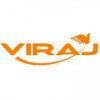Filter interviews by
Jindal Steel and Power Tool & DIE Maker Interview Questions and Answers
6 Interview questions
Jigs and fixtures are tools used in manufacturing to hold and guide workpieces during machining operations.
Jigs are used to guide and control the cutting tools, while fixtures are used to hold and position the workpiece.
Jigs are typically used for drilling, reaming, and tapping operations, while fixtures are used for milling, grinding, and turning operations.
Jigs are often more complex and expensive than fixtures ...
Conventional machining refers to traditional methods of shaping and cutting materials, while non-conventional machining involves newer, unconventional techniques.
Conventional machining uses tools like lathes, milling machines, and drills to remove material through cutting, grinding, or drilling processes.
Non-conventional machining includes methods like laser cutting, electrochemical machining, and ultrasonic machi...
Moulding is a manufacturing process used to shape liquid or pliable raw materials into solid objects.
Moulding involves pouring or injecting a material into a mould or die.
The material is then allowed to cool and harden, taking the shape of the mould.
Common materials used in moulding include plastics, metals, and ceramics.
Moulding is used in various industries such as automotive, aerospace, and consumer goods.
Examp...
Tool & die refers to the specialized field of manufacturing and repairing tools, dies, and molds used in various industries.
Tool & die makers create and maintain precision tools, dies, and molds.
They work with materials like metal, plastic, and wood to produce parts and components.
Tool & die making involves using various machines, such as lathes, milling machines, and grinders.
These professionals interpret bluepri...
What people are saying about Jindal Steel and Power






Injection molding and blow molding are two different processes used in manufacturing plastic products.
Injection molding involves injecting molten plastic into a mold to create a solid object.
Blow molding involves inflating a hollow tube of molten plastic to create a hollow object.
Injection molding is used for producing solid objects like bottle caps, while blow molding is used for producing hollow objects like bot...
A jig is used to control and guide the cutting tool to a specific location on a workpiece, while fixtures are used to support and locate the workpiece.
Jigs are typically used in machining operations to ensure accuracy and repeatability.
Fixtures are often used in manufacturing processes to securely hold the workpiece in place.
Jigs and fixtures are essential tools in tool and die making, as they help in achieving pr...
Jindal Steel and Power Tool & DIE Maker Interview Experiences
1 interview found
I applied via Approached by Company and was interviewed in Aug 2023. There was 1 interview round.
(6 Questions)
- Q1. What is Tool & die
- Ans.
Tool & die refers to the specialized field of manufacturing and repairing tools, dies, and molds used in various industries.
Tool & die makers create and maintain precision tools, dies, and molds.
They work with materials like metal, plastic, and wood to produce parts and components.
Tool & die making involves using various machines, such as lathes, milling machines, and grinders.
These professionals interpret blueprints, ...
- Q2. The difference between Jig & fixtures
- Ans.
Jigs and fixtures are tools used in manufacturing to hold and guide workpieces during machining operations.
Jigs are used to guide and control the cutting tools, while fixtures are used to hold and position the workpiece.
Jigs are typically used for drilling, reaming, and tapping operations, while fixtures are used for milling, grinding, and turning operations.
Jigs are often more complex and expensive than fixtures due t...
- Q3. A Jig controls and guides the cutting tool to work predefiend location on workpiece. Fixtures are used for supporting and locating a workpiece
- Ans.
A jig is used to control and guide the cutting tool to a specific location on a workpiece, while fixtures are used to support and locate the workpiece.
Jigs are typically used in machining operations to ensure accuracy and repeatability.
Fixtures are often used in manufacturing processes to securely hold the workpiece in place.
Jigs and fixtures are essential tools in tool and die making, as they help in achieving precise...
- Q4. What is the moulding
- Ans.
Moulding is a manufacturing process used to shape liquid or pliable raw materials into solid objects.
Moulding involves pouring or injecting a material into a mould or die.
The material is then allowed to cool and harden, taking the shape of the mould.
Common materials used in moulding include plastics, metals, and ceramics.
Moulding is used in various industries such as automotive, aerospace, and consumer goods.
Examples o...
- Q5. The Difference between Conventional machining & non-conventional
- Ans.
Conventional machining refers to traditional methods of shaping and cutting materials, while non-conventional machining involves newer, unconventional techniques.
Conventional machining uses tools like lathes, milling machines, and drills to remove material through cutting, grinding, or drilling processes.
Non-conventional machining includes methods like laser cutting, electrochemical machining, and ultrasonic machining.
...
- Q6. The difference between injection molding & blow moulding
- Ans.
Injection molding and blow molding are two different processes used in manufacturing plastic products.
Injection molding involves injecting molten plastic into a mold to create a solid object.
Blow molding involves inflating a hollow tube of molten plastic to create a hollow object.
Injection molding is used for producing solid objects like bottle caps, while blow molding is used for producing hollow objects like bottles.
...
Interview Preparation Tips
- Production Department
- Press Tools
- Moulds
- VMC
- Ncn
- Grinding Machine
- Cylindrical Grinding
- Conventional Machines
Interview questions from similar companies

I applied via Campus Placement and was interviewed in Jul 2022. There were 2 interview rounds.

(3 Questions)
- Q1. Injection Tooling.And Press Tool
- Q2. Injection Die costing
- Q3. Die Costing. Press process
Interview Preparation Tips

I applied via Naukri.com and was interviewed before Dec 2020. There was 1 interview round.
Interview Questionnaire
2 Questions
- Q1. Channel for retail marketing.
- Ans.
Retail marketing channels include online, brick-and-mortar stores, direct mail, and social media.
Online channels such as e-commerce websites and marketplaces
Brick-and-mortar stores like department stores and specialty shops
Direct mail campaigns including catalogs and flyers
Social media platforms like Facebook and Instagram
In-store promotions and events
- Q2. Distributor channel sales.
Interview Preparation Tips

I applied via Company Website and was interviewed before Sep 2021. There were 2 interview rounds.

(1 Question)
- Q1. Asked only your job related question
Interview Preparation Tips
What people are saying about Jindal Steel and Power







I applied via Company Website and was interviewed before Nov 2018. There were 5 interview rounds.
Interview Questionnaire
2 Questions
- Q1. Interviewer asked questions based on resume contents
- Q2. Just honest reply
Interview Preparation Tips

Interview Questionnaire
1 Question
- Q1. Iron-Carbon Phase diagram, CCT curves, Pearlite,lever rule
Interview Preparation Tips
Experience: It was online test and was aptitude section first. Questions were easy and later there were questions on English grammer and comprehension which would require 10th level knowledge. At last there will be 25 technical questions. Surprisingly, most of them were factual.
Tips: Pick up any aptitude book and practise it to improve your problem solving speed.
Duration: 1 hour 30 minutes
Total Questions: 90
Round: Technical + HR Interview
Experience: I was asked to draw Iron Carbon phase diagram and CCT curves. I was also tested about lever rule and eutectoid composition.
Tips: Coursework would suffice
College Name: IIT Madras

Interview Questionnaire
1 Question
- Q1. Tell me about yourself. Questions regarding Iron-Carbon diagram and CCT curves
Interview Preparation Tips
Experience: Basically there were some aptitude questions which were easy and English grammer(10th level) was asked. About technical aspect, questions were mostly factual.
Tips: For technical, prepare specifically for factual questions from your coursework. For aptitude part, focus on speed of solving problems.
Duration: 1 hour 30 minutes
Total Questions: 90
Round: Technical + HR Interview
Experience: I was asked about myself and extra-curricular activities first followed by some technical questions about iron-carbon phase diagram and lever rule.
Tips: Course work would suffice
College Name: IIT Madras

I applied via Company Website and was interviewed in Jul 2018. There were 5 interview rounds.
Interview Questionnaire
2 Questions
- Q1. One important incident in your carrier where you think you have contributed effectively in your organization
- Ans.
Implemented a new customer feedback system resulting in increased customer satisfaction and retention rates.
Identified the need for a more efficient feedback system
Researched and implemented a new software to collect and analyze customer feedback
Analyzed the data to identify trends and areas for improvement
Implemented changes based on feedback leading to improved customer satisfaction and retention rates
- Q2. What extra zeal you have that You can be hired
- Ans.
I have a strong passion for leadership and a proven track record of motivating teams to achieve success.
Proven track record of successfully leading teams in previous roles
Passionate about developing and mentoring team members
Strong communication and interpersonal skills
Ability to problem-solve and make quick decisions under pressure
Interview Preparation Tips
Experience: Reasoning, English and core subject
Round: Test
Experience: Psychometric
General Tips: Be just yourself, don't lie an inch neither exxagerate things. Coj interviewer understands very quickly your caliber and vague things.
Skills: Communication, Body Language, Analytical Skills
Duration: >3 Months

I applied via Job Fair and was interviewed before Feb 2021. There was 1 interview round.
(1 Question)
- Q1. BASIC ENGINEERING QUESTIONS, PROJECT RELATED QUESTIONS
Interview Preparation Tips

I applied via Recruitment Consultant and was interviewed in May 2019. There were 3 interview rounds.
Interview Questionnaire
2 Questions
- Q1. Most important question-What have you done in previous organization and what's your roles?
- Q2. Tell me something about yourself? And All questions related to your resume (data written there)
Interview Preparation Tips
Any big issues which you have resolved during your career.
Jindal Steel and Power Interview FAQs
Some of the top questions asked at the Jindal Steel and Power Tool & DIE Maker interview -
Tell us how to improve this page.
Jindal Steel and Power Interviews By Designations
- Jindal Steel and Power Junior Engineer Interview Questions
- Jindal Steel and Power Assistant Manager Interview Questions
- Jindal Steel and Power Graduate Engineer Trainee (Get) Interview Questions
- Jindal Steel and Power Deputy Manager Interview Questions
- Jindal Steel and Power Electrical Engineer Interview Questions
- Jindal Steel and Power Electrician Interview Questions
- Jindal Steel and Power Assistant Engineer Interview Questions
- Jindal Steel and Power Manager Interview Questions
- Show more
Interview Questions for Popular Designations
Overall Interview Experience Rating
based on 1 interview experience
Difficulty level
Duration
Interview Questions from Similar Companies
|
Assistant Manager
2.4k
salaries
| ₹6 L/yr - ₹14 L/yr |
|
Deputy Manager
1.1k
salaries
| ₹9.6 L/yr - ₹16.5 L/yr |
|
Junior Engineer
912
salaries
| ₹2 L/yr - ₹5.6 L/yr |
|
Assistant Engineer
882
salaries
| ₹3.8 L/yr - ₹8.5 L/yr |
|
Manager
647
salaries
| ₹13.1 L/yr - ₹22 L/yr |

Tata Steel

JSW Steel

ArcelorMittal Nippon Steel

Jindal Stainless
- Home >
- Interviews >
- Jindal Steel and Power Interview Questions












